Forest at Crows Foot Track. Silver gelatin photograph There was…
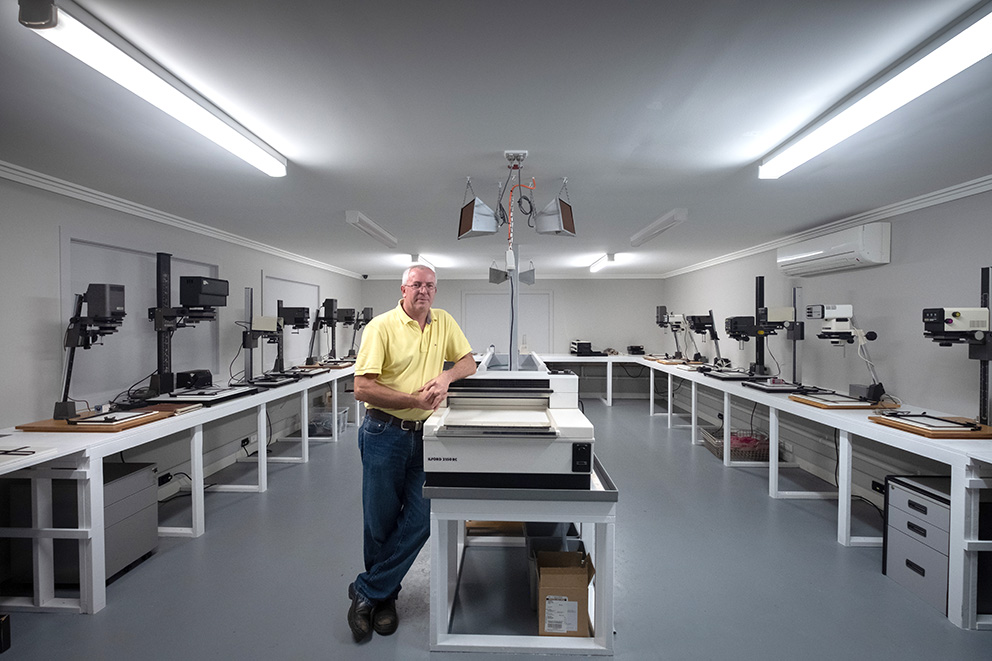
Darkroom – Craig Watson – part two
My life in darkrooms by Craig Watson part two.
By 2018 the bottom had fallen out of the magazine market, particularly for motoring, and I was looking for something to do that still involved photography but would reignite my passion for it. After lengthy research and doing a Cert 4 in New Business Management, I took the gamble of my life and started Focal Point Darkroom and Gallery in North Geelong, in February 2019.
Although the gallery was a major part of the business, hosting some of the best photographic exhibitions seen in Geelong, including the Nikon-Walkley Press Photography Exhibition for five years running, it was the darkroom that was the true centrepiece of the business.
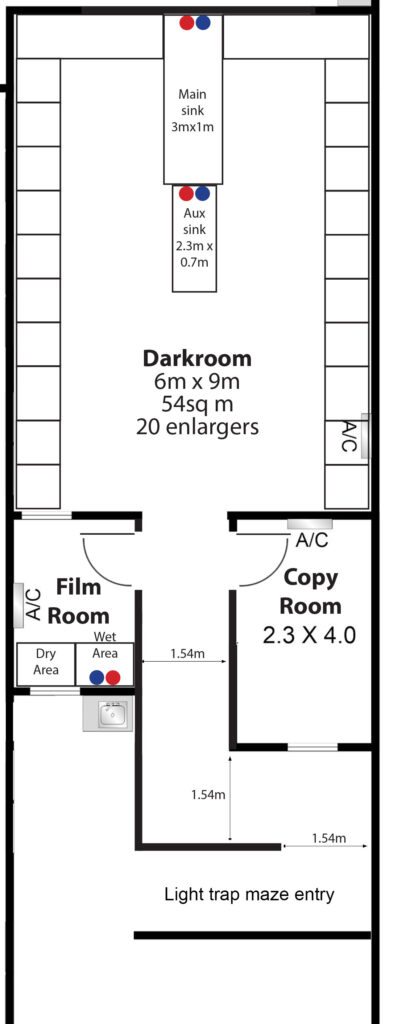
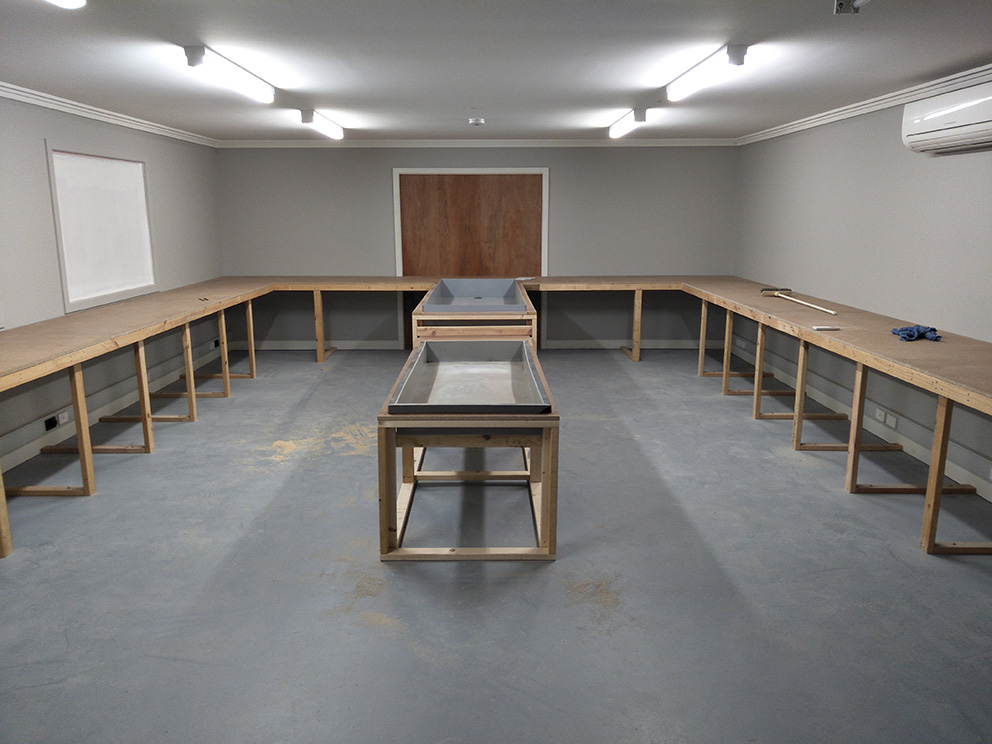
My research included visiting the darkrooms at Melbourne Polytechnic (which had the best darkroom and photographic department I’ve seen anywhere), Deakin University in Geelong and the three public access darkrooms then operating in Melbourne – Fox, Noir and Strange Neighbour. I also met Brian Murray, who many of our readers may know or know of, and saw his very impressive home darkroom – the best home darkroom I have seen, bar none.
Taking ideas from all of these sources, and with more space available than I ever thought I would have, I built an impressive darkroom with 20 enlargers, two with drop-boards, as well as separate small darkrooms for film processing and scanning.
I spent over $20,000 setting up the darkrooms alone, making it the largest and best-equipped public-access darkroom in Australia. That is, and was, a big call, with the emphasis on public-access, but I challenge anyone to prove otherwise.
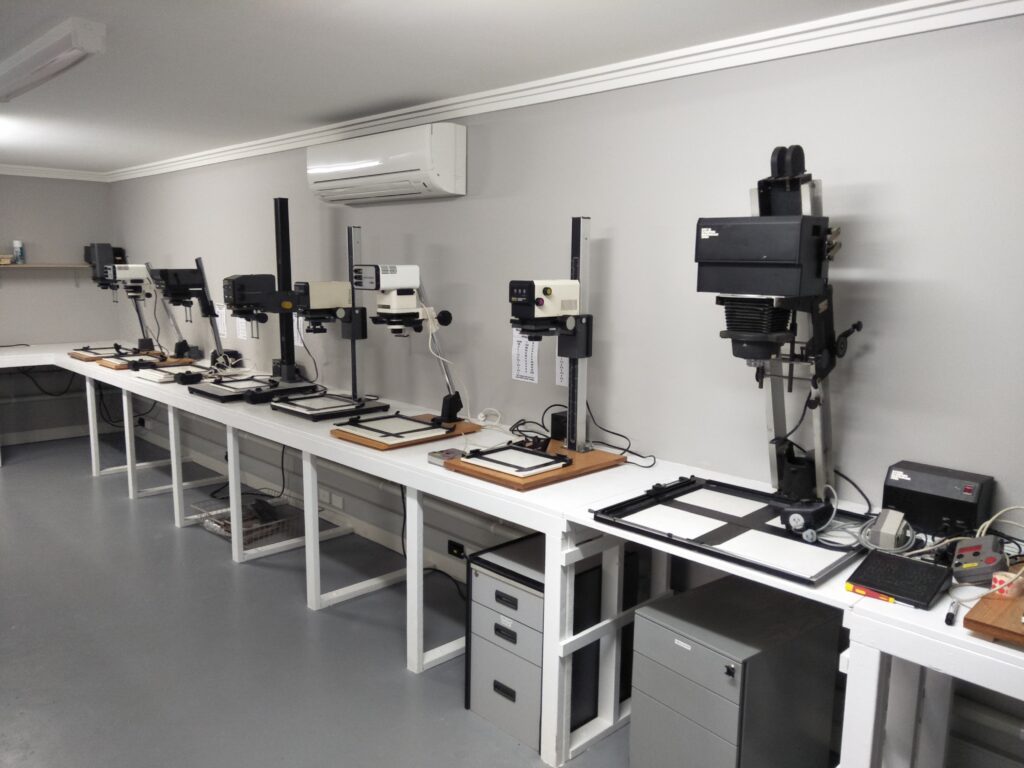
My enlargers were initially a hotch-potch, with my original LPL7700 colour and the old HWT Omega D2 Multigrade having pride of place. The rest of the enlargers were basically anything I could get cheaply at the time. I managed to get another couple of LPL7700 colour enlargers very affordably on-line and rescued eight Meopta Axomat 5 enlargers from a school that was dismantling its darkroom.
I also scored a couple of Durst M605 colour enlargers and one Durst M670 Multigrade from an old colleague at HWT, and former Press Photographer of the Year, Clive Mackinnon, as well as an Ilford 1250 RC print dryer.
Brian Murray sold me an Ilford 2150 RC paper processor that took a print dry to dry in 70 seconds, and a Polaroid MP4 copy camera at very reasonable prices. The MP4 actually didn’t get any use until four years later when I based my DSLR scanning set-up around it, but has since proved invaluable to my business.
My intention had always been to provide the best darkroom experience around for people wanting to hire a darkroom, to offer darkroom training and workshops for those interested in learning the basics or improving their skills, and to bring in schools for whole-class darkroom training – hence the 20 enlargers.

Over time I sold many of the enlargers I had acquired in order to buy better ones and to standardise as much as possible, for consistency with large groups. Within a fairly short time I had replaced most of the Meopta enlargers with LPL7700 colour, had got hold of another Omega D2 Multigrade and had a Durst Laborator 138S 5 x 7 B&W enlarger on loan from one of my customers.
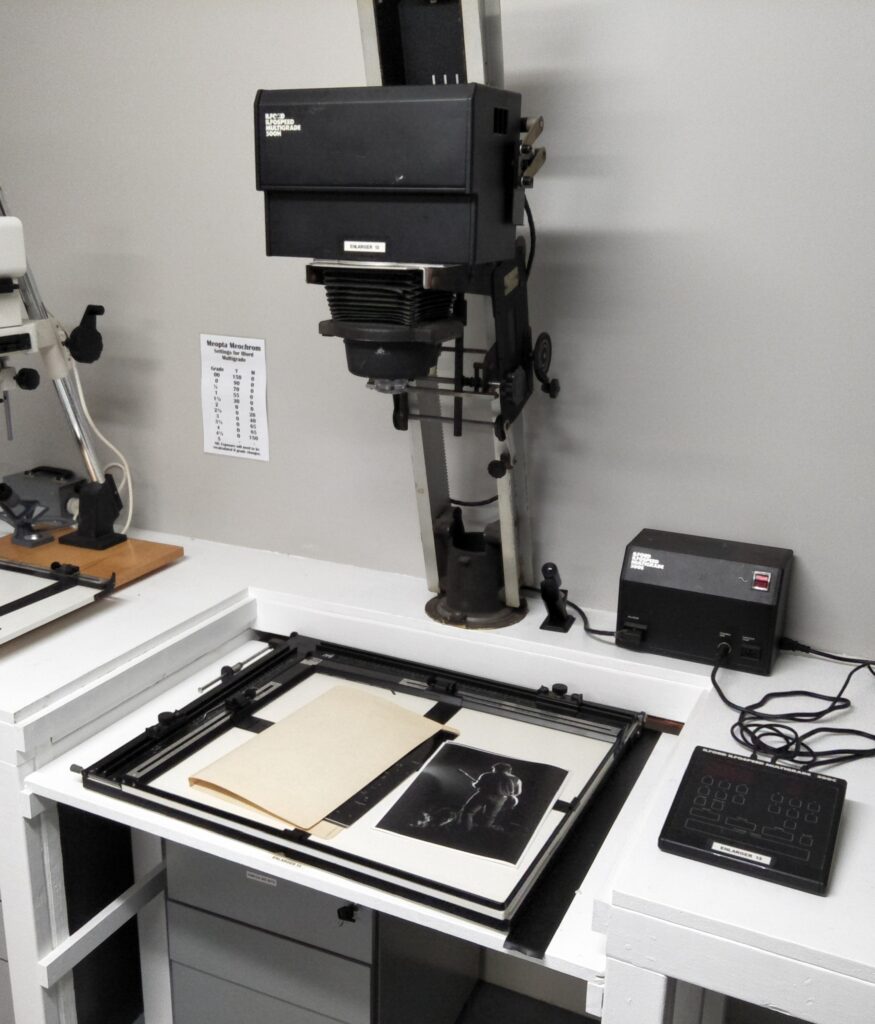
Down the centre of the darkroom were two sinks, accessible from both sides and large enough to process 20 x 24 prints. One of the sinks was lower than the other, to accommodate shorter people (ie kids) or people in wheelchairs. I always intended my darkroom to be wheelchair-accessible, but the one thing that held me back was finding the perfect enlarger, a De Vere 504 Multigrade, that I could afford.
2019 saw a good start to the business, with a number of workshops, plenty of individual darkroom training and a good number of people hiring the darkroom, although getting schools interested was proving impossible.
Then in March 2020, when the business looked like it was powering ahead and I had been a finalist in the new business section of the Geelong Business Excellence Awards, we were hit by COVID.
We all know what happened then. After suffering through two years of snap lockdowns and ongoing restrictions and being closed for five months in total, my business had been smashed. I was fortunate to get some state government assistance in 2021, after going it alone the previous year and unable to claim Job Keeper, but it was only enough to pay the rent and electricity. In other words, it allowed us to still be there when the dust settled, but with the pandemic declared over at the end of the year and all government assistance ending, we were expected to make up for two disastrous years with the “post-COVID recovery”. For the Arts at least, that recovery never came and by the time it looked like it might we were thrown into the cycle of interest rate increases, economic downturn and the cost-of-living crisis.
A general change in people’s priorities and reluctance to spend on anything beyond the essentials had a major impact on my business. Where before COVID we had good sales in every exhibition, now sales virtually dried up. Where darkroom workshops had been sold out, now they were cancelled due to a lack of interest, and where we had a fairly steady flow of people hiring the darkroom, now they were a rarity.
One physical impact this had on the darkroom, particularly with no interest being shown by any local schools, was that the number of enlargers was reduced to twelve, with those remaining being the best I could find.
After four years of struggling financially and with other personal major changes happening in my life, I took the decision to close Focal Point down in October last year, selling most of my equipment to someone who took over my lease.
After trying to work from home for three months and finding myself constantly distracted with other things to do around the house, I knew I needed a new work space.
I was fortunate to get onto The Hue & Cry Collective in Ryrie St, Geelong, which in many ways resembled Focal Point, with a large gallery holding different exhibitions every month, but catering to all visual art. At the back of the gallery is Analogue Academy where colour negative films are processed and scanned. Upstairs are about a dozen small studios rented out by various artists.
I took over one of these studios, where I have my computer desk, Epson 7890 printer, DSLR scanning station and a second computer desk, a small fridge to keep my film (and my lunch), a couple of filing cabinets and plenty of shelving – all in a space 3m x 3m.

Most importantly, there is a small darkroom there but it had been poorly built with many light leaks and no ventilation. I was told that as I am the only person using the darkroom, I could change anything I wanted. So, I basically gutted it and started again. However, I had to be very mindful of my budget. Because I don’t own the space, I wasn’t going to spend a lot of money doing it, which meant not buying a proper darkroom sink.
Despite the sink situation, and a lack of running hot water (which has been overcome with a small electric urn) it is a functional and efficient little darkroom that is very similar to my old home darkroom in Melton.
Now the place is properly light tight, with plenty of ventilation and a small heater for these cold winter days, and is a very comfortable work space.
On the wall to the left of the central door I have my two Omega D2 enlargers. One is set up for printing 35mm and medium format, while the other is virtually permanently set up for 4 x 5. The bench, which was already there but very wobbly, has been attached to the wall and is now nice and solid. Under the bench is a shelf for storing paper and large processing trays, and below that is plenty of storage space. On the wall to the right of the enlargers I have three shelves for storage, which are separated from the wet area bench by a small gap. Directly opposite the door is a wide work bench which has the Ilford 1250 RC print dryer and enough space for processing film.
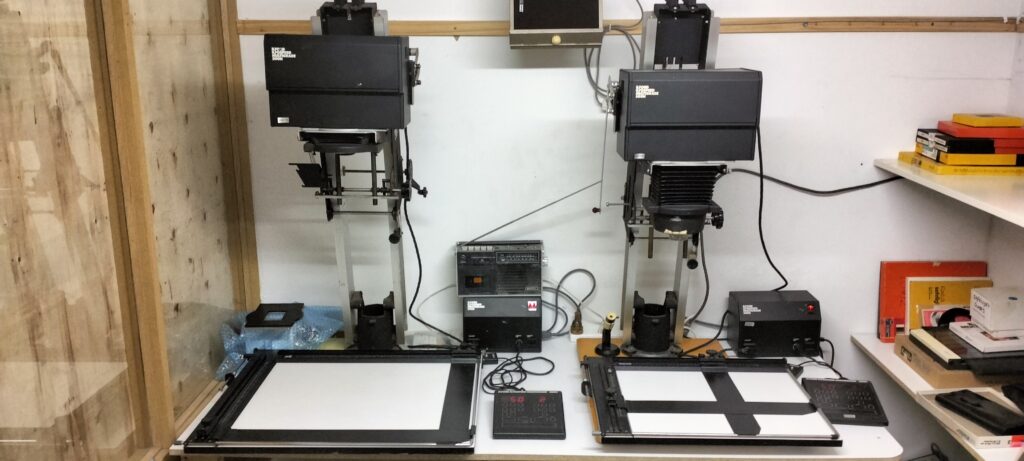
The wet bench continues at a right-angle along the third wall, where there is a standard single kitchen sink. It is not ideal, but with a board on top there is plenty of space to process 16 x 20 prints. 20 x 24 trays might fit at a squeeze. At least there is cold running water and the afore mentioned small hot water urn just fits on the edge of the sink.
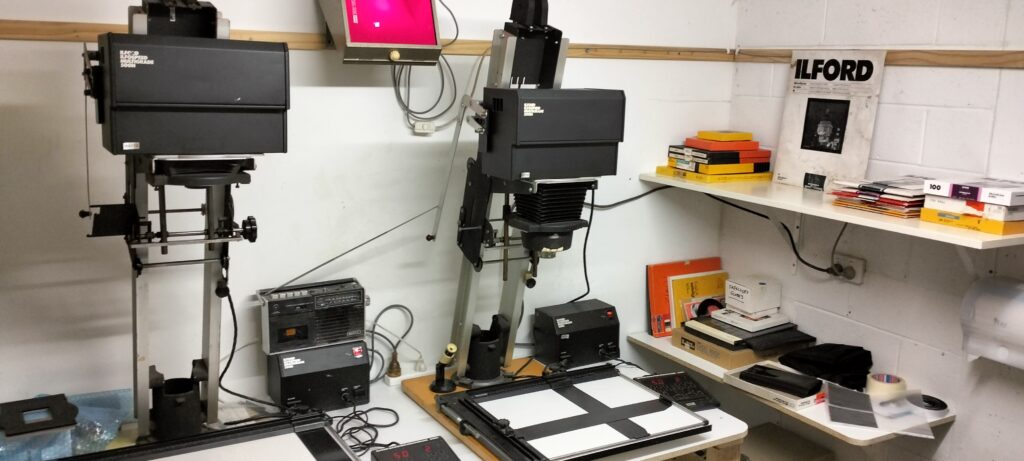
Above the sink are some wire drying racks for all my beakers, measuring jugs and film processing tanks. On the short wall to the right, above the sink, are another couple of small drying racks for the tank reels, tongs, etc.
Below the sink is a cupboard for storing my chemicals, and beside that a couple of shelves for more storage. Above the print dryer is a shelf for storing all my dry developing tanks and a few other odds and sods.
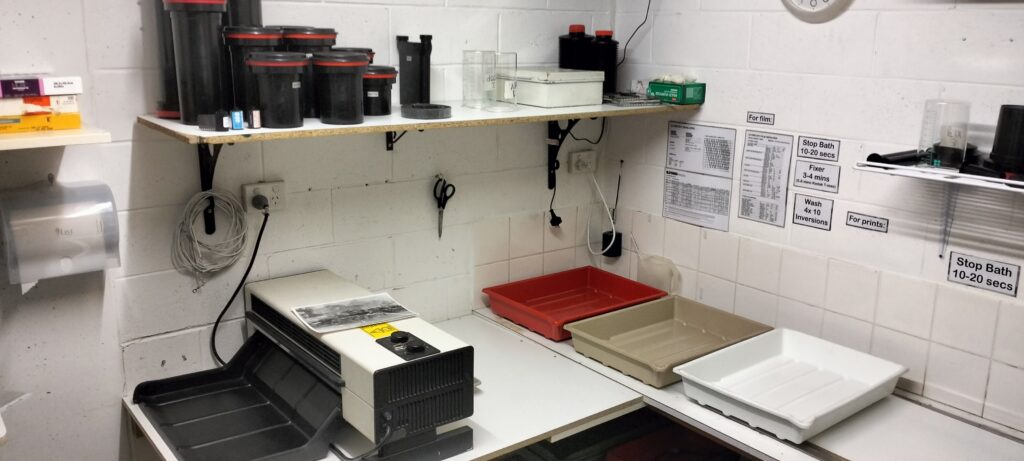
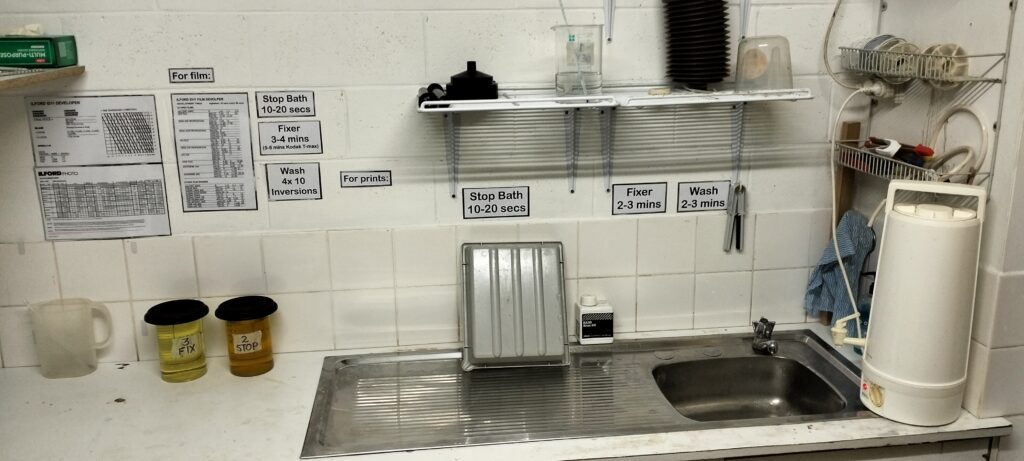
I use the Patterson System 4 processing tanks for 35mm and 120 film processing and for 4×5 film I have a Stearman Press SP445 processing tank, which I find a joy to use.
I don’t currently have the darkroom set up for fibre-based paper, but the next job planned is to put in some drying racks below the RC print dryer and some wire for hanging prints above the sink.
The entire darkroom is only about 1.8m by 2.6m, but it all works and is very comfortable. I have rubber mats on the concrete floor for a bit more comfort and a radio tuned into the local station for tunes to while away the day.
I was recently gifted a Graflex Speed Graphic (4×5) press camera from the 1950s and have been experimenting with in-camera multiple exposures, shot hand-held – so far with about a 50% success rate, which I’m pretty happy about.
I’m also planning on shooting some events with it, hand-held and in the style of the old press hounds. It should be fun. At least now I have the space where I can process the films and print them in my little darkroom.
The darkroom at The Hue & Cry Collective can be booked by contacting Craig Watson at wattophoto@gmail.com.au or via The Hue & Cry website.
Part one of this article can be seen here.
Main photograph at top: Craig Watson in Focal Point darkroom. Photograph by Noel Butcher.




A very nostalgic read, for I too spent a lot of time in the H&W Times darkroom many years ago and I too, had an LPL 7700 colour enlarger in my private darkroom. My 3rd and latest latest darkroom hasn’t been used as a darkroom for more than two decades but does admiral service as a “storage facility”. And I thought I recognised that picture at the top of the page!
Nostalgic indeed! Hopefully the resurgence in film photography is reflected in more activity in your darkroom. My personal darkroom was a safe haven for me over many years, but that stage of my life has now passed and I will eventually have to find a new home for my kit. If you enjoy good enlargers you might have room for my Durst Laborator 1200 (35mm to 4×5) and my Leitz Focomat V35!